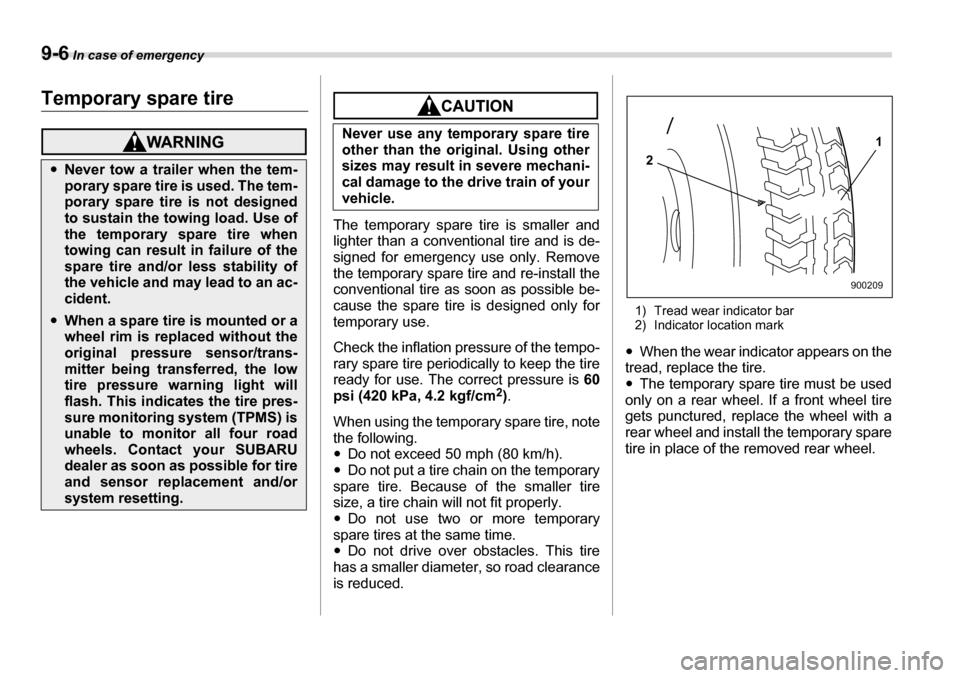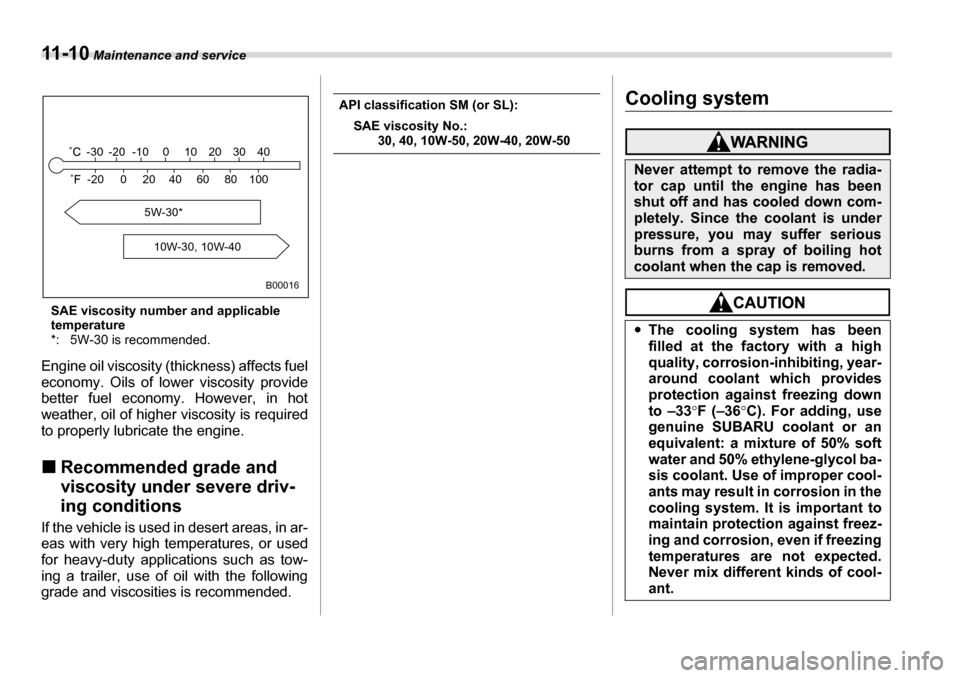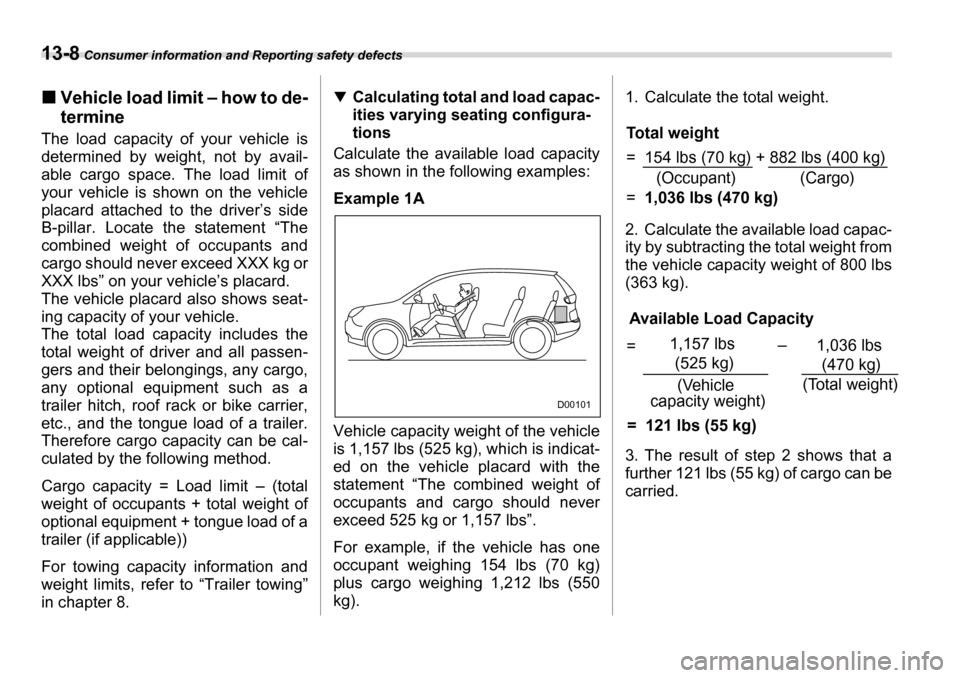Page 277 of 377

9-6 In case of emergency
Temporary spare tire
The temporary spare tire is smaller and
lighter than a conventional tire and is de-
signed for emergency use only. Remove
the temporary spare tire and re-install the
conventional tire as soon as possible be-
cause the spare tire is designed only for
temporary use.
Check the inflation pressure of the tempo-
rary spare tire periodically to keep the tire
ready for use. The correct pressure is 60
psi (420 kPa, 4.2 kgf/cm 2
).
When using the temporary spare tire, note
the following.�y Do not exceed 50 mph (80 km/h).
�y Do not put a tire chain on the temporary
spare tire. Because of the smaller tire
size, a tire chain will not fit properly. �y Do not use two or more temporary
spare tires at the same time. �y Do not drive over obstacles. This tire
has a smaller diameter, so road clearance
is reduced. 1) Tread wear indicator bar
2) Indicator location mark
�y When the wear indicator appears on the
tread, replace the tire. �y The temporary spare tire must be used
only on a rear wheel. If a front wheel tire
gets punctured, replace the wheel with a
rear wheel and install the temporary spare
tire in place of the removed rear wheel.
�y Never tow a trailer when the tem-
porary spare tire is used. The tem-
porary spare tire is not designed
to sustain the towing load. Use of
the temporary spare tire when
towing can result in failure of the
spare tire and/or less stability of
the vehicle and may lead to an ac-
cident.
�yWhen a spare tire is mounted or a
wheel rim is replaced without the
original pressure sensor/trans-
mitter being transferred, the low
tire pressure warning light will
flash. This indicates the tire pres-
sure monitoring system (TPMS) is
unable to monitor all four road
wheels. Contact your SUBARU
dealer as soon as possible for tire
and sensor replacement and/or
system resetting.
Never use any temporary spare tire
other than the original. Using other
sizes may result in severe mechani-
cal damage to the drive train of your
vehicle.1
2
900209
Page 307 of 377

11 - 1 0 Maintenance and service
SAE viscosity number and applicable
temperature
*: 5W-30 is recommended.
Engine oil viscosity (thickness) affects fuel
economy. Oils of lower viscosity provide
better fuel economy. However, in hot
weather, oil of higher viscosity is required
to properly lubricate the engine. �„ Recommended grade and
viscosity under severe driv-
ing conditions
If the vehicle is used in desert areas, in ar-
eas with very high temperatures, or used
for heavy-duty applications such as tow-
ing a trailer, use of oil with the following
grade and viscosities is recommended.
API classification SM (or SL):
SAE viscosity No.:
30, 40, 10W-50, 20W-40, 20W-50
Cooling system
5W-30*
10W-30, 10W-40
-30 -20 -10 0 10 20 30 40
-20 0 60 20 80 10040
B00016
Never attempt to remove the radia-
tor cap until the engine has been
shut off and has cooled down com-
pletely. Since the coolant is under
pressure, you may suffer serious
burns from a spray of boiling hot
coolant when the cap is removed. �yThe cooling system has been filled at the factory with a high
quality, corrosion-inhibiting, year-
around coolant which provides
protection against freezing down
to –33 °F (–36 °C). For adding, use
genuine SUBARU coolant or an
equivalent: a mixture of 50% soft
water and 50% ethylene-glycol ba-
sis coolant. Use of improper cool-
ants may result in corrosion in the
cooling system. It is important tomaintain protection against freez-
ing and corrosion, even if freezing
temperatures are not expected.
Never mix different kinds of cool-
ant.
Page 346 of 377
Specifications 12-3
– CONTINUED –
�„Electrical system
�„ Capacities
�„ Tires
Battery type and capacity (5HR)75D23L (12V–52AH)
Alternator12V–110A
Spark plugsILFR6B (NGK)
Fuel tank16.9 US gal (64 liters, 14.1 Imp gal)
Engine oil5.8 US qt (5.5 liters, 4.8 Imp qt)
Transmission fluid10.4 US qt (9.8 liters, 8.6 Imp qt)
AT differential gear oil1.5 US qt (1.4 liters, 1.2 Imp qt)
Rear differential gear oil0.8 US qt (0.8 liter, 0.7 Imp qt)
Power steering fluid0.9 US qt (0.9 liter, 0.8 Imp qt)
Engine coolant7.8 US qt (7.4 liters, 6.5 Imp qt)
Tire sizeP255/55R18
Wheel size18 × 8JJ
PressureFront33 psi (230 kPa, 2.3 kgf/cm 2
)
Rear32 psi (220 kPa, 2.2 kgf/cm 2
)
Rear at trailer towing32 psi (220 kPa, 2.2 kgf/cm 2
)
Temporary spare tireSizeT165/80R17
Pressure60 psi (420 kPa, 4.2 kgf/cm 2
)
Page 348 of 377
Specifications 12-5
– CONTINUED –
Fuses and circuits �„Fuse panel located in the passenger compart- ment
27 28 29 30 31 32 33
20 21 22 23 24 25 26
13 14 15 16 17 18 19
6789101112 12345
C00004
Fuse panelFuse ratingCircuit
120A�y
Trailer hitch connector
2Empty
315A�yDoor locking
47.5A�yFront wiper deicer relay
�y Moonroof
57.5A�yCombination meter
67.5A�yRemote control rear view mirrors
�y Seat heater relay
715A�yCombination meter
�y Integrated unit
820A�yStop light
920A�yMirror heater
�y Front wiper deicer
107.5A�yPower supply (Battery)
117.5A�yTurn signal unit
1215A�yAutomatic transmission unit
�y SRS airbag system (Sub)
�y Engine control unit
�y Integrated unit
1320A�yCargo socket
Page 358 of 377
Consumer information and Reporting safety defects 13-5
– CONTINUED –
�„Recommended tire inflation pressure
�T Recommended cold tire inflation pressure
Recommended cold tire inflation pressure for your vehicle’s tires is as follows,
Tire sizeP255/55R18 104H
Wheel size18 × 8JJ
PressureFront33 psi (230 kPa, 2.3 kgf/cm 2
)
Rear32 psi (220 kPa, 2.2 kgf/cm 2
)
Rear at trailer towing32 psi (220 kPa, 2.2 kgf/cm 2
)
Temporary spare tireSizeT165/80R17
Pressure60 psi (420 kPa, 4.2 kgf/cm 2
)
Page 361 of 377

13-8 Consumer information and Reporting safety defects
�„Vehicle load limit – how to de- termine
The load capacity of your vehicle is
determined by weight, not by avail-
able cargo space. The load limit of
your vehicle is shown on the vehicle
placard attached to the driver’s side
B-pillar. Locate the statement “The
combined weight of occupants and
cargo should never exceed XXX kg or
XXX lbs” on your vehicle’s placard.
The vehicle placard also shows seat-
ing capacity of your vehicle.
The total load capacity includes the
total weight of driver and all passen-
gers and their belongings, any cargo,
any optional equipment such as a
trailer hitch, roof rack or bike carrier,
etc., and the tongue load of a trailer.
Therefore cargo capacity can be cal-
culated by the following method.
Cargo capacity = Load limit – (total
weight of occupants + total weight of
optional equipment + tongue load of a trailer (if applicable))
For towing capacity information and
weight limits, refer to “Trailer towing”
in chapter 8. �T
Calculating total and load capac-
ities varying seating configura-
tions
Calculate the available load capacity
as shown in the following examples:
Example 1A
Vehicle capacity weight of the vehicle
is 1,157 lbs (525 kg), which is indicat-
ed on the vehicle placard with the
statement “The combined weight of
occupants and cargo should never
exceed 525 kg or 1,157 lbs”.
For example, if the vehicle has one
occupant weighing 154 lbs (70 kg)
plus cargo weighing 1,212 lbs (550 kg). 1. Calculate the total weight.
2. Calculate the available load capac-
ity by subtracting the total weight from
the vehicle capacity weight of 800 lbs
(363 kg).
3. The result of step 2 shows that a
further 121 lbs (55 kg) of cargo can be carried.
D00101
Total weight = 154 lbs (70 kg) + 882 lbs (400 kg) =
1,036 lbs (470 kg)(Occupant) (Cargo)
Available Load Capacity
(Vehicle
capacity weight) (Total weight)
= 121 lbs (55 kg) 1,157 lbs
(525 kg) 1,036 lbs
(470 kg)
–
=
Page 362 of 377

Consumer information and Reporting safety defects 13-9
– CONTINUED –
Example 1B
For example, if a person weighing 176
lbs (80 kg) now enters the same vehi-
cle (bringing the number of occupants
to two), the calculations are as fol-
lows:
1. Calculate the total weight.
2. Calculate the available load capac- ity.
3. The total weight now exceeds the
capacity weight by 55 lbs (25 kg), so
the cargo weight must be reduced by
55 lbs (25 kg) or more.
Example 2A
Vehicle capacity weight of the vehicle
is 1,157 lbs (525 kg), which is indicat-
ed on the vehicle placard with the
statement “The combined weight of
occupants and cargo should never
exceed 525 kg or 1,157 lbs”.
For example, the vehicle has one oc-
cupant weighing 165 lbs (75 kg) plus
cargo weighing 705 lbs (320 kg). In
addition, the vehicle is fitted with a
trailer hitch weighing 22 lbs (10 kg), to
which is attached a trailer weighing
1,764 lbs (800 kg). 10% of the trailer
weight is applied to the trailer tongue
(i.e. Tongue load = 176 lbs (80 kg)).
1. Calculate the total weight.
2. Calculate the available load capac-
ity.
D00102
Total weight = 154 lbs (70 kg) + 176 lbs (80 kg) + 882 lbs (400 kg) =
1,212 lbs (550 kg) (Occupant)
(Cargo)
Available Load Capacity
(Vehicle
capacity weight) (Total weight)
1,157 lbs
(525 kg) 1,212 lbs
(550 kg)
= –55 lbs (–25 kg) –
=
D00103
Total weight
= 165 lbs (75 kg) + 705 lbs (320 kg)
+ 22 lbs (10 kg) + 176 lbs (80 kg) = 1,069 lbs (485 kg)(Occupant) (Cargo)
(Trailer hitch) (Tongue load)
Page 363 of 377

13-10 Consumer information and Reporting safety defects
3. The result of step 2 shows that a
further 88 lbs (40 kg) of cargo can becarried.
Example 2B
For example, if a person weighing 143
lbs (65 kg) and a child weighing 40 lbs
(18 kg) now enter the same vehicle
(bringing the number of occupants to three), and a child restraint system
weighing 11 lbs (5 kg) is installed in
the vehicle for the child to use, the cal-
culations are as follows:
1. Calculate the total weight.
2. Calculate the available load capac- ity.
3. The total weight now exceeds the
capacity weight by 105 lbs (48 kg), so
the cargo weight must be reduced by
105 lbs (48 kg) or more.
�„ Determining compatibility of
tire and vehicle load capaci-ties
The sum of four tires’ maximum load
ratings must exceed the maximum
loaded vehicle weight (“GVWR”). In
addition, sum of the maximum load
ratings of two front tires and of two
rear tires must exceed each axle’s
maximum loaded capacity (“GAWR”).
Original equipment tires are designed to fulfill those conditions.
The maximum loaded vehicle weight
is referred to Gross Vehicle Weight
Rating (GVWR). And each axle’s
Available Load Capacity
(Vehicle
capacity weight) (Total weight)
1,157 lbs
(525 kg) 1,069 lbs
(485 kg)
= 88 lbs (40 kg) –
=
D00104
Total weight
(Occupant) (Cargo)
(Trailer hitch)
(Child restraint)
(Tongue load)
165 lbs
(75 kg) 143 lbs
(65 kg) 40 lbs
(18 kg)
++
11 lbs (5 kg) 705 lbs (320 kg)
22 lbs (10 kg) 176 lbs (80 kg)
= 1,263 lbs (573 kg)
+
+
+
+
=
Available Load Capacity
(Vehicle
capacity weight) (Total weight)
1,157 lbs
(525 kg) 1,263 lbs
(573 kg)
= –105 lbs (–48 kg) –
=